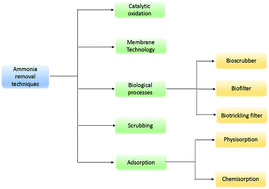Metal–organic frameworks (MOFs): potential and challenges for capture and abatement of ammonia
Abstract
Metal–organic frameworks (MOFs) have potential as air quality treatment media for various gaseous pollutants (e.g., ammonia) through diverse mechanisms (capture and catalytic degradation). A broad range of MOFs have been developed with numerous advantageous properties (e.g., high surface area, high degree of porosity, intrinsically tunable chemical structure, flexible architecture, and multifunctional properties) to meet strict air quality metrics. Nevertheless, the practical use of these novel materials has also been restricted due to certain drawbacks including high fabrication costs, poor selectivity, low capacity, and difficulties in recycling/regeneration. This review was organized to highlight the recent advancements in MOF technology for the mitigation of ammonia. The article aims to expand the use of MOFs in air quality treatments by identifying the research gaps in associated fields.

- This article is part of the themed collection: Recent Review Articles


 Please wait while we load your content...
Please wait while we load your content...